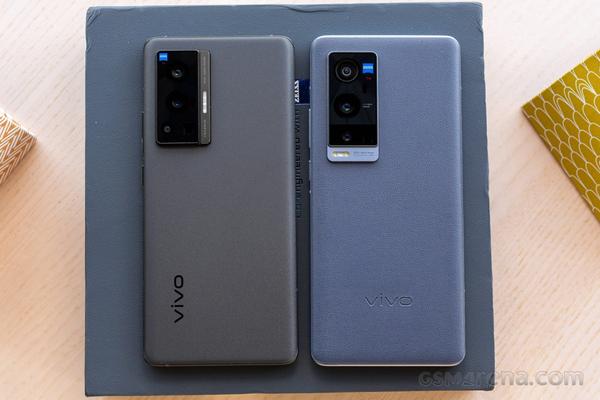Even before you open the vivo X70 Pro box you are greeted with a “Co-engineered with ZEISS” label on the front. The box itself is somewhat small, but it is actually one of the better-stocked retail packages we’ve seen recently.
Once you lift the lid you see the phone itself and another label: “Photography. Redefined”. It’s quite clear what the main selling point of the X70 series is and we will get to that in a moment. First, lets us rifle through what’s inside the box.
The first thing to note is the FlashCharge 44W power adapter. It offers a USB-A port that can deliver up to 11V and 4A. The necessary USB-A to C cable is hidden below the transparent protective case and some documentation on the side. And no, your eyes do not deceive you, that is a wired headset.
The vivo X70 Pro and X70 Pro+ are in for review • 44W fast charger, cable, headphones, adapter and case
While the phone itself lacks a 3.5 mm jack, the box for the headset comes with a USB-C to 3.5 mm adapter. Also inside are two pairs of rubber tips of different sizes. The headset has an in-ear design and actually looks pretty nice.
We’re putting all these accessories aside to look at the phone. We received the Cosmic Black version for our review. It’s odd – the back looks like it has a matte finish, but it is actually quite smooth, almost slippery. Combine that with the curved display and getting a firm grip on the X70 Pro is not easy.
The Cosmic Black back is slippery • The curved screen looks cool, but doesn't help with grip
Also, quad camera bump protrudes significantly from the back. In fact, the protective glass over the cameras are the tallest thing on the back (the LED flash strip is slightly lower). The included case has a lip around the camera cutout, which puts a little distance between the table and the glass. If you go commando with this phone you should be careful when putting it down.
It’s quite a camera, though. The ZEISS T* logo denotes the special coating on the lenses that reduces reflections (which can cause ghosting and flare). And it’s not just the coating, ZEISS and vivo engineered the imaging system of the X70 (and older X60) series together.

The vivo X70 Pro+ features the proprietary V1 image processing chip, which the global X70 Pro lacks
The main camera features a large 50MP sensor that Sony customized for vivo, the IMX766V. The custom bit is a different color filter array that is thinner and more transparent – it lets in around 4.6% more light compared to the IMX766 available to other makers.
It is a large 1/1.56” sensor with 1.0µm pixels and 4-in-1 binning. This camera features vivo’s new Gimbal Stabilization 3.0 system, which works in 5 axes – X/Y/Z axis rotation and X/Y axis translation. Building on top of the hardware stabilization is an in-house EIS algorithm.
The vivo X70 Pro (global) camera uses a custom IMX766V sensor and ZEISS T* anti-reflective coating
There are two telephoto cameras, one 12MP unit with a 50mm lens (2x magnification) for portrait shots and one 8MP unit with a 125mm periscope lens (5x). Both have OIS. Also here is a 12MP ultrawide camera.
The global version of the X70 Pro (which is what we have) lacks the V1 imaging chip, that’s only for the X70 Pro+ and the Chinese X70 Pro. We do have a Pro+ on hand, so when we’re done with the reviews we will have an idea of how much the lack of the V1 impacts the performance.
Portrait mode is available with the main, portrait and periscope cameras. The main and periscope ones offer special modes that simulate the bokeh of some famous ZEISS lens styles – Biotar, Sonnar, Planar and Distagon. You can dial in the virtual aperture to get as much (or as little) depth of field as you want.
The IMX766V isn’t the only custom chip in this phone, there’s also the Dimensity 1200-vivo chipset. It features tweaked ISP and APU (AI Processing Unit) that can better handle vivo’s image processing algorithms for Super Night Mode Astro Mode and Pro Sports Mode. Compared to the vanilla Dimensity 1200, this one is 30% more efficient at running said image processing algorithms.
The vivo X70 Pro is equipped with a 120 Hz AMOLED display, a Samsung E5 panel. It has 1080p+ resolution (19.8:9 aspect ratio) and a touch sampling rate of 240Hz. The custom Dimensity chipset and the FunctouchOS 12 software feel very snappy.
6.56" 1080p+ LTPS AMOLED panel • 120 Hz and 60 Hz refresh rate options
The vivo X70 Pro is heavily customized: custom image sensor, custom chipset, custom software. All of those promise to give it an edge over the competition that uses off-the-shelf components – but does it actually? That’s a question for the upcoming full review.
The global rollout for the X70 Pro and X70 Pro+ has already started and pre-orders are live in India
